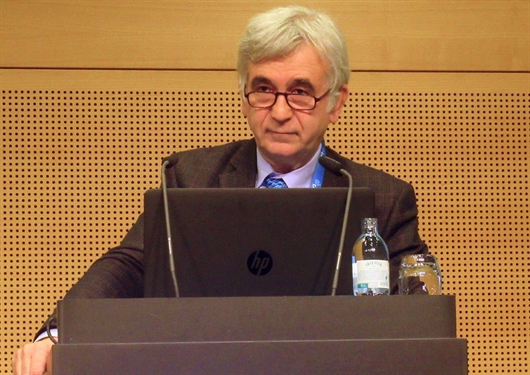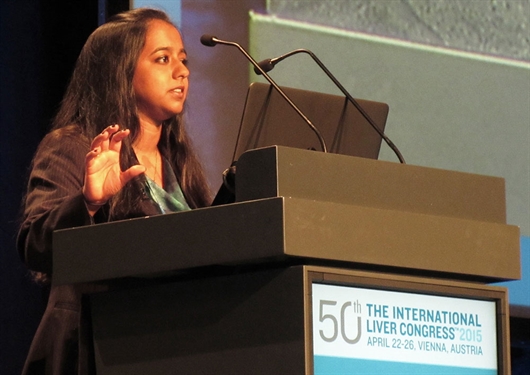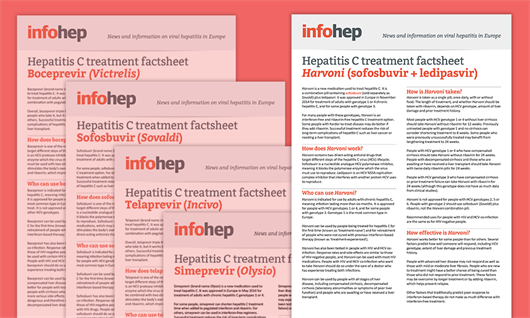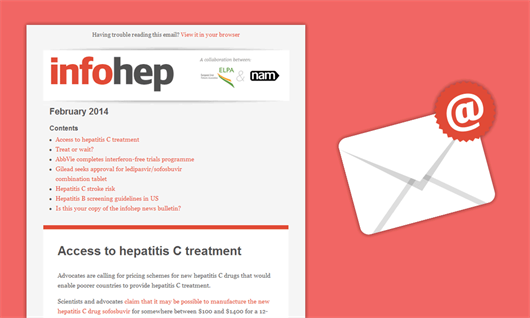More news from the International Liver Congress 2015 This edition of the infohep.org bulletin is again devoted to news
from the International Liver Congress 2015, the 50th annual meeting
of the European Association for the Study of the Liver (EASL), which took place
22-26 April in Vienna, Austria. The previous edition of this bulletin focused on important new
research on direct-acting antiviral treatment for hepatitis C presented to the Congress. You can read it on our website.
Hepatitis B news Hepatitis B prevention and treatment had a higher profile
at this year’s International Liver Congress in Vienna, which took place in late
April. Global gaps in immunisation coverage and treatment availability were
highlighted by a mathematical model developed by researchers from Imperial
College, London. Using available data on the epidemiology and natural
history of hepatitis B, researchers projected that without further
intervention, the number of people living with hepatitis B will remain at
current high levels for the next 40-50 years and there will be 20 million HBV-related
deaths by 2030.
Modelling
showed that incidence of new cases of chronic HBV infection could be reduced by
90% and mortality could fall by 65% by 2030 if the following interventions are
implemented:
- Infant vaccination scaled up
to >95%.
- 80% receive the birth dose
of the vaccine and hepatitis B immune globulin (HBIG) and antivirals to
interrupt mother-to-child transmission.
- A 90/90/90 strategy for
people already infected: 90% screened for HBV, 90% of those eligible being
treated, and 90% of those treated achieving durable viral suppression from
the year 2020 onward.
This
translates to an estimated 13 million deaths averted worldwide, including 6
million due to cancer. The projected global cost for expanded prevention and
treatment would peak at US$7.5 billion (£5 billion) annually, but then decline
rapidly after 2030.
The cost of treatment could be reduced substantially by use
of generic versions of antiviral drugs. Large
scale generic production of entecavir, one of two antiviral drugs recommended
as first-line treatment for hepatitis B, could reduce the annual cost of
treatment per person to US$36 a year, according to another study published
by researchers from Imperial College, London. The patent on entecavir has
already expired in the United States and will expire in many other countries
over the next few years.
A
large European cohort study presented at the International Liver Congress
showed that five-year survival without liver transplantation among people
receiving tenofovir or entecavir treatment for hepatitis B was very high, at
95%. Transplant-free survival was marginally lower in people who had cirrhosis
at the time they started treatment (92% at 5 years). However, 4.6% of all
patients developed hepatocellular carcinoma (liver cancer), of which only 56%
survived for at least three years after diagnosis.
Another
European study looked at the discontinuation of tenofovir treatment in people
with hepatitis B after a prolonged period of suppression of HBV DNA.
Preliminary results of the study showed that participants experienced modest
increases in HBV DNA and liver enzymes after one year off treatment, and HBV
DNA and ALT levels tended to improve as time off treatment continued.
Treating
chronic hepatitis B with tenofovir plus pegylated interferon for 48 weeks
resulted in a higher rate of hepatitis B surface antigen (HBsAg) clearance than
either drug taken alone, though the response rate was still just 9%,
according to another study presented at the International Liver Congress. Other
researchers reported that adding interferon to nucleoside/nucleotide therapy
increased the rate of HBsAg loss to about the same level, and switching to
interferon may be effective for selected patients.
Hepatitis delta Hepatitis
delta is a small virus that can only replicate in the presence of hepatitis B
virus (HBV). Over years or decades, chronic hepatitis B can lead to advanced
liver disease including cirrhosis and liver cancer. Disease progression is more
rapid and more severe in people with HBV and hepatitis delta virus (HDV)
co-infection.
There is
currently no standard treatment for hepatitis D. Interferon can stimulate the
immune response against both HBV and HDV, but hepatitis B treatment using
nucleoside/nucleotide analogues such as entecavir (Baraclude) or
tenofovir (Viread) only minimally suppresses HDV.
An estimated 15 million people have hepatitis delta
worldwide – or about 5% of all people with hepatitis B. While Europe and the US
have designated hepatitis delta as an orphan disease due to the small overall
numbers of people infected, prevalence is much higher in certain regions
including Turkey, Russia, and parts of Central Asia, China, Africa and South
America.

Cihan Yurdaydin of Ankara University School of Medicine. Photo by Liz Highleyman, hivandhepatitis.com Two studies reported promising early-stage results for drugs
that target hepatitis delta. Lonafarnib,
an inhibitor of viral assembly, reduced hepatitis delta viral load
substantially when combined with pegylated interferon or with ritonavir (an
agent already used for boosting other drugs). Hepatitis delta viral load began
to increase after treatment stopped. Further studies will investigate longer
durations of treatment. REP
2139-Ca, a nucleic acid polymer, lowered hepatitis B surface antigen
(HBsAg) levels and significantly reduced hepatitis B and hepatitis delta viral
loads when combined with pegylated interferon 2a. Montreal-based Replicor is
developing nucleic acid polymers for the treatment of both hepatitis B and
hepatitis delta.
Statins and cirrhosis Statins are
used to lower blood cholesterol levels. They have been shown to prevent
cardiovascular disease and reduce the risk of heart attack, stroke and death.
Statins also have anti-inflammatory effects and some research has found them to
be associated with reduced liver fibrosis progression and lower risk of liver
cancer.
Studies have
also shown that statins can decrease portal pressure – blood pressure in the
veins that carry blood from the stomach and intestines through the liver – in
people with cirrhosis and to improve survival in people with bleeding varices.

Arpan Mohanty of Yale University School of Medicine. Photo by Liz Highleyman, hivandhepatitis.com
A
review of US military veterans with hepatitis C found that users of statins
were significantly less likely to progress to decompensated disease and less
likely to die if they used statins to control blood cholesterol.
The study matched each statin user with hepatitis C and
cirrhosis to five non-users of statins with hepatitis C and cirrhosis. Over a
two-year follow-up period, statins reduced the risk of decompensation and death
by approximately 45%.
Another study of US military veterans, published in April,
found that statins improved the likelihood of cure in people treated for
hepatitis C, as well as reducing the risk of progression of cirrhosis and the
incidence of hepatocellular carcinoma (liver cancer).
Hepatitis C and cancer Over years or decades, chronic hepatitis C virus (HCV)
infection can lead to advanced liver disease including cirrhosis and
hepatocellular carcinoma (HCC), a type of liver cancer. But the effects of HCV
infection elsewhere in the body are not fully understood. Chronic hepatitis C
has been linked to cardiovascular disease, diabetes and several other
conditions including non-Hodgkin's lymphoma; its association with other kinds
of cancer is unknown.

Anders Nyberg of Kaiser Permanente San Diego. Photo by Liz Highleyman, hivandhepatitis.com
A
study of a large population in southern California has found that people
with hepatitis C had two-to-fourfold higher rates of several types of cancer
when compared to people without hepatitis C, including colorectal cancer and
cancers of the prostate, stomach, pancreas, kidney, lung and oesophagus, as
well as head and neck cancer. After taking into account the cancer risks
associated with smoking, heavy alcohol use and diabetes, the risk of liver
cancer and non-Hodgkin’s lymphoma remained significantly higher in people with
hepatitis C.
Hepatitis C treatment Numerous studies are underway to investigate whether the
duration of hepatitis C treatment can be shortened. A shorter treatment course
might be cheaper, and so allow more people to be cured. It would also make
treatment easier for people who have difficulty in taking medication.
The current thinking among pharmaceutical companies and
researchers is that in order to shorten treatment substantially, a successful
regimen will need to combine drugs that act at several different points in the
virus life cycle, in order to shut down virus replication as quickly as
possible. Studies are looking at three-drug combinations.
Two studies presented at the International Liver Congress
reported on shortening treatment courses, showing that if currently available
drugs are used, it is unlikely that the duration of treatment can be pushed
below 6 weeks. One study also showed that for genotype 3 hepatitis C, shorter
treatment courses may be feasible.
The
C-SWIFT study looked at the combination of the Merck HCV protease inhibitor grazoprevir,
the NS5A inhibitor elbasvir and Gilead’s NS5B polymerase inhibitor sofosbuvir.
The study found that shortening hepatitis C treatment to 6 weeks for
easier-to-treat patients without cirrhosis did not greatly reduce the efficacy
of hepatitis C treatment for people with genotype 1 infection. On the other
hand, a 4-week course of treatment performed poorly in people without
cirrhosis. The study found that people with cirrhosis and genotype 1 infection
needed an 8-week course of treatment, as did people with genotype 3 infection
without cirrhosis.
A
6-week regimen of sofosbuvir (Sovaldi) plus two experimental
direct-acting antivirals being developed by Gilead Sciences cured more than
90% of previously untreated people with genotype 1 hepatitis C virus and no
liver cirrhosis in a smaller study. A 4-week regimen was not effective for any
group, however, and 6 weeks appears inadequate for harder-to-treat patients.
The regimen consisted of sofosbuvir, the pan-genotypic NS5A inhibitor GS-5816
(veltapasvir) and the pan-genotypic HCV protease inhibitor GS-9857.
Access to treatment
Gilead has faced continuing pressure over the past few
months to ease restrictions on generic production of its hepatitis C drugs, in
order to make them more accessible in middle-income countries. Activists
have called on the company to relax the restrictions that prevent generic
versions produced under licence in India from being sold in 51 middle-income
countries. The Hep Coalition has criticised plans to extend the mandate of the
Medicines Patent Pool to hepatitis C direct-acting antivirals. They say that
the Medicines Patent Pool risks reinforcing the restrictions imposed by Gilead
on access in middle-income countries, and voluntary licensing allows
pharmaceutical companies, not governments and their people, to decide where
affordable generic drugs are available.
In Latin America, where 2.6 million people have hepatitis C,
governments
are considering whether they can set up a pooled procurement mechanism, in
order to negotiate lower prices for sofosbuvir (Sovaldi) and simeprevir (Olysio).
In the United States, the
US government is being urged to use compulsory licensing to allow generic
versions of hepatitis C drugs to be used in US Veterans Affairs hospitals for
former military personnel. These hospitals are funded directly by the US
government, unlike the rest of the health care system, and treat an estimated
220,000 people who might eventually need hepatitis C treatment.
However, Gilead takes the view that its drugs are fairly
priced, and
justifies this view by arguing that the cost of a treatment course is lower
than the cost of a liver transplant and hospitalisation for advanced liver
disease if hepatitis C is left untreated.
Hepatitis C treatment factsheets 
We have recently published a new factsheet on Harvoni, an addition to the five other hepatitis C treatment factsheets. Each factsheet focuses on one direct-acting antiviral drug and gives an overview of how it works, who can use it, how it is taken, what trial results tell us about how effective it is, known side-effects and drug interactions. The factsheets are available to read online, and are also designed to be printed and shared.
Is this your copy of the infohep news bulletin? 
Is this your copy of the infohep news bulletin, or did you receive it from a friend or colleague, or find it online? You can sign up to receive this monthly email bulletin, free of charge, on our website, where you can also find an archive of all the infohep news bulletins.
|







Connect with infohep on Facebook: Keep up to date with all the latest news and developments.
Follow infohep on Twitter for links to news stories and updates from infohep.org. Follow us at www.twitter.com/infohep.
Follow all the infohep news by subscribing to our RSS feeds.